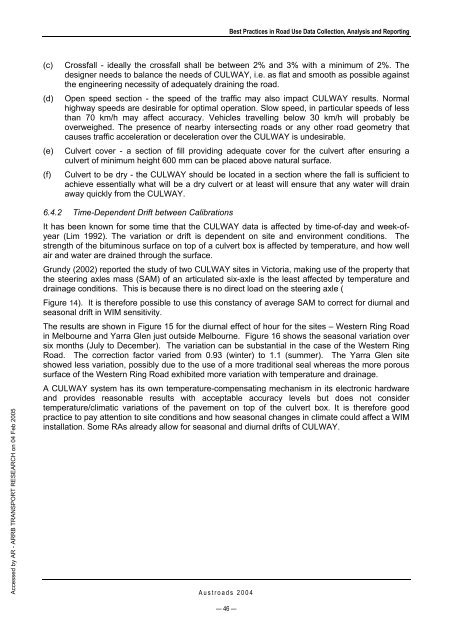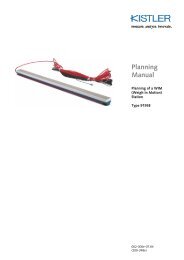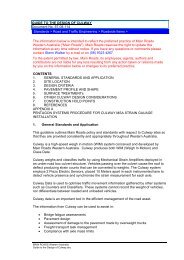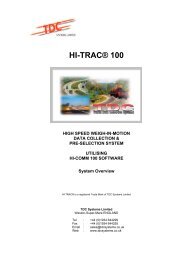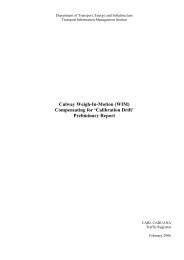AP-G84/04 Best practice in road use data collection, analysis ... - WIM
AP-G84/04 Best practice in road use data collection, analysis ... - WIM
AP-G84/04 Best practice in road use data collection, analysis ... - WIM
You also want an ePaper? Increase the reach of your titles
YUMPU automatically turns print PDFs into web optimized ePapers that Google loves.
Accessed by AR - ARRB TRANSPORT RESEARCH on <strong>04</strong> Feb 2005<br />
Aust<strong>road</strong>s 20<strong>04</strong><br />
— 46 —<br />
<strong>Best</strong> Practices <strong>in</strong> Road Use Data Collection, Analysis and Report<strong>in</strong>g<br />
(c) Crossfall - ideally the crossfall shall be between 2% and 3% with a m<strong>in</strong>imum of 2%. The<br />
designer needs to balance the needs of CULWAY, i.e. as flat and smooth as possible aga<strong>in</strong>st<br />
the eng<strong>in</strong>eer<strong>in</strong>g necessity of adequately dra<strong>in</strong><strong>in</strong>g the <strong>road</strong>.<br />
(d) Open speed section - the speed of the traffic may also impact CULWAY results. Normal<br />
highway speeds are desirable for optimal operation. Slow speed, <strong>in</strong> particular speeds of less<br />
than 70 km/h may affect accuracy. Vehicles travell<strong>in</strong>g below 30 km/h will probably be<br />
overweighed. The presence of nearby <strong>in</strong>tersect<strong>in</strong>g <strong>road</strong>s or any other <strong>road</strong> geometry that<br />
ca<strong>use</strong>s traffic acceleration or deceleration over the CULWAY is undesirable.<br />
(e) Culvert cover - a section of fill provid<strong>in</strong>g adequate cover for the culvert after ensur<strong>in</strong>g a<br />
culvert of m<strong>in</strong>imum height 600 mm can be placed above natural surface.<br />
(f) Culvert to be dry - the CULWAY should be located <strong>in</strong> a section where the fall is sufficient to<br />
achieve essentially what will be a dry culvert or at least will ensure that any water will dra<strong>in</strong><br />
away quickly from the CULWAY.<br />
6.4.2 Time-Dependent Drift between Calibrations<br />
It has been known for some time that the CULWAY <strong>data</strong> is affected by time-of-day and week-ofyear<br />
(Lim 1992). The variation or drift is dependent on site and environment conditions. The<br />
strength of the bitum<strong>in</strong>ous surface on top of a culvert box is affected by temperature, and how well<br />
air and water are dra<strong>in</strong>ed through the surface.<br />
Grundy (2002) reported the study of two CULWAY sites <strong>in</strong> Victoria, mak<strong>in</strong>g <strong>use</strong> of the property that<br />
the steer<strong>in</strong>g axles mass (SAM) of an articulated six-axle is the least affected by temperature and<br />
dra<strong>in</strong>age conditions. This is beca<strong>use</strong> there is no direct load on the steer<strong>in</strong>g axle (<br />
Figure 14). It is therefore possible to <strong>use</strong> this constancy of average SAM to correct for diurnal and<br />
seasonal drift <strong>in</strong> <strong>WIM</strong> sensitivity.<br />
The results are shown <strong>in</strong> Figure 15 for the diurnal effect of hour for the sites – Western R<strong>in</strong>g Road<br />
<strong>in</strong> Melbourne and Yarra Glen just outside Melbourne. Figure 16 shows the seasonal variation over<br />
six months (July to December). The variation can be substantial <strong>in</strong> the case of the Western R<strong>in</strong>g<br />
Road. The correction factor varied from 0.93 (w<strong>in</strong>ter) to 1.1 (summer). The Yarra Glen site<br />
showed less variation, possibly due to the <strong>use</strong> of a more traditional seal whereas the more porous<br />
surface of the Western R<strong>in</strong>g Road exhibited more variation with temperature and dra<strong>in</strong>age.<br />
A CULWAY system has its own temperature-compensat<strong>in</strong>g mechanism <strong>in</strong> its electronic hardware<br />
and provides reasonable results with acceptable accuracy levels but does not consider<br />
temperature/climatic variations of the pavement on top of the culvert box. It is therefore good<br />
<strong>practice</strong> to pay attention to site conditions and how seasonal changes <strong>in</strong> climate could affect a <strong>WIM</strong><br />
<strong>in</strong>stallation. Some RAs already allow for seasonal and diurnal drifts of CULWAY.


